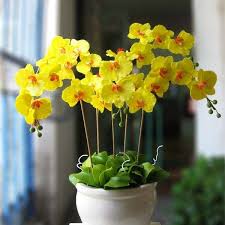# How to Clean and Preserve White Egg Orchids for Longevity

## Introduction
White Egg Orchids, also known as **Dendrobium**, are renowned for their stunning beauty and delicate fragrance. These orchids are a popular choice for both indoor and outdoor arrangements, symbolizing purity, love, and elegance. However, like any floral arrangement, proper care is essential to maintain their beauty and extend their lifespan. This article will guide you through the best practices for cleaning and preserving White Egg Orchids, ensuring that they remain vibrant and fresh for as long as possible.
## 1. Understanding White Egg Orchids
### 1.1 Characteristics of White Egg Orchids
White Egg Orchids are characterized by their striking white flowers and slender, elegant stems. They can bloom for several weeks to months, depending on the care they receive. To appreciate their beauty fully, it’s essential to understand their growth habits and needs.
### 1.2 Ideal Growing Conditions
These orchids thrive in warm, humid environments, preferring bright, indirect sunlight. They require well-draining potting media and should be watered regularly but not overwatered. Understanding these conditions is vital for keeping them healthy and prolonging their lifespan.
## 2. Cleaning White Egg Orchids
Cleaning your White Egg Orchids is an essential step in maintaining their beauty. Dust and debris can accumulate on the leaves and flowers, affecting their overall health and appearance. Here’s a step-by-step guide on how to clean them effectively.
### 2.1 Gather Your Supplies
Before you start cleaning, gather the following supplies:
– Soft microfiber cloth or sponge
– Lukewarm water
– Spray bottle
– Mild soap (optional)
– A pair of scissors or shears (for trimming)
### 2.2 Prepare the Cleaning Solution
Fill a spray bottle with lukewarm water. If the orchids are particularly dirty, you can add a few drops of mild soap to the water. Make sure the soap is gentle and free from harsh chemicals, as these can damage the delicate petals.
### 2.3 Cleaning the Leaves
1. **Dampen the Cloth**: Moisten the microfiber cloth or sponge with the cleaning solution. Ensure it is not too wet, as excess moisture can harm the plant.
2. **Wipe the Leaves**: Gently wipe each leaf, starting from the base and moving toward the tip. This motion helps remove dust and any sticky residue.
3. **Check for Pests**: While cleaning, examine the leaves for any signs of pests, such as aphids or spider mites. If you notice any, treat them immediately with an appropriate insecticidal soap.
### 2.4 Cleaning the Flowers
1. **Spray the Flowers**: Lightly mist the flowers with the cleaning solution. Avoid soaking them, as excess water can lead to mold and rot.
2. **Wipe Gently**: If necessary, use a damp cloth to gently wipe the petals. Be very careful, as the petals are delicate and can be easily bruised.
3. **Remove Dead Flowers**: If you notice any wilted or dead blooms, carefully remove them by cutting them at the base of the stem. This not only improves the appearance of the plant but also encourages new growth.
### 2.5 Final Inspection
Once you’ve cleaned the leaves and flowers, give your orchids a final inspection. Check for any signs of disease or distress, such as yellowing leaves or black spots, and take appropriate action if needed.
## 3. Preserving White Egg Orchids
Preserving your White Egg Orchids is crucial for maintaining their beauty over time. Here are several methods to ensure your orchids stay fresh and vibrant.
### 3.1 Proper Watering Techniques
1. **Watering Frequency**: Water your orchids regularly, allowing the top inch of the soil to dry out between waterings. This helps prevent root rot, which can damage the plant and shorten its lifespan.
2. **Use Room Temperature Water**: Always use lukewarm or room temperature water to avoid shocking the roots. Cold water can stress the plant and lead to wilting.
3. **Watering Method**: When watering, use a watering can or a spray bottle to ensure even distribution. Avoid pouring water directly onto the leaves or flowers, as this can promote mold growth.
### 3.2 Optimal Lighting Conditions
1. **Indirect Sunlight**: Place your White Egg Orchids in a location that receives bright, indirect sunlight. Too much direct sunlight can scorch the leaves and petals, while too little light can stunt growth.
2. **Rotate Regularly**: To ensure even growth, rotate the pot every few weeks. This helps prevent the plant from leaning toward the light source and promotes balanced growth.
### 3.3 Humidity Control
1. **Maintain Humidity**: White Egg Orchids thrive in high humidity. Use a humidity tray filled with water and pebbles beneath the pot to create a humid microclimate.
2. **Misting**: Lightly mist the leaves and flowers regularly, especially during dry months. This helps maintain the necessary humidity levels for the orchids.
3. **Avoid Dry Air**: Keep the orchids away from heaters or air conditioning vents, as these can dry out the air and stress the plants.
### 3.4 Fertilization
1. **Use Orchid-Specific Fertilizer**: Feed your White Egg Orchids with a balanced, water-soluble orchid fertilizer every two weeks during the growing season (spring and summer). Dilute it to half the recommended strength to avoid over-fertilization.
2. **Adjust During Dormancy**: In fall and winter, reduce fertilization to once a month or stop altogether, as orchids enter a dormant phase.
### 3.5 Re-potting
1. **When to Re-pot**: Re-pot your White Egg Orchids every 1-2 years or when the potting media breaks down. Signs that it’s time to re-pot include roots growing out of the drainage holes or the plant becoming root-bound.
2. **Choose the Right Media**: Use a well-draining orchid mix, typically consisting of bark, perlite, and charcoal. This helps maintain moisture while allowing excess water to escape.
3. **Re-potting Process**:
– Gently remove the orchid from its current pot.
– Trim any dead or damaged roots with sterilized scissors.
– Place the orchid in a new pot, filling it with fresh potting media and ensuring the crown is above the media.
## 4. Creative Ways to Display White Egg Orchids
Displaying your White Egg Orchids beautifully can enhance your home decor while also keeping them in good condition. Here are some ideas for creative arrangements:
### 4.1 Using Decorative Pots
Choose decorative pots that complement your home’s style. Ensure they have drainage holes to prevent water accumulation, which can lead to root rot.
### 4.2 Creating Arrangements
1. **Single Stem Vases**: Use a tall, slender vase to showcase a single stem of White Egg Orchids. This minimalist approach highlights their elegance.
2. **Mixed Arrangements**: Combine White Egg Orchids with other flowers and greenery to create a vibrant bouquet. Choose complementary colors to enhance the overall aesthetic.
3. **Hanging Displays**: Consider using macramé hangers to create a vertical garden. Hanging your orchids adds visual interest and allows for better light exposure.
### 4.3 Seasonal Displays
1. **Festive Arrangements**: Incorporate White Egg Orchids into seasonal decorations, such as holiday centerpieces. Their beauty adds a touch of elegance to any celebration.
2. **Outdoor Displays**: If you have a garden, consider planting your White Egg Orchids in pots that can be moved outdoors during warmer months. This allows them to soak up the natural sunlight they crave.
## 5. Troubleshooting Common Issues
Even with the best care, your White Egg Orchids may encounter issues. Here are some common problems and their solutions:
### 5.1 Yellowing Leaves
– **Cause**: Overwatering or poor drainage.
– **Solution**: Check the potting media and ensure it is well-draining. Reduce watering frequency and allow the soil to dry out slightly before watering again.
### 5.2 Wilting Flowers
– **Cause**: Underwatering or sudden temperature changes.
– **Solution**: Check the moisture level of the potting media and adjust your watering routine. Ensure the orchids are not exposed to drafts or sudden temperature fluctuations.
### 5.3 Pests
– **Common Pests**: Aphids, spider mites, and mealybugs.
– **Solution**: Inspect your orchids regularly for pests. Use insecticidal soap or neem oil to treat infestations, following the instructions on the product label.
## 6. Conclusion
Caring for White Egg Orchids involves understanding their unique needs and providing the right environment for them to thrive. By following the cleaning and preservation methods outlined in this article, you can ensure that your orchids remain healthy, vibrant, and beautiful for an extended period.
Remember to clean your orchids regularly, maintain optimal growing conditions, and troubleshoot any issues that arise. With the proper care, your White Egg Orchids will not only enhance your living space but also bring joy and tranquility to your life. Embrace the beauty of these stunning flowers and enjoy their elegance for years to come!
—

